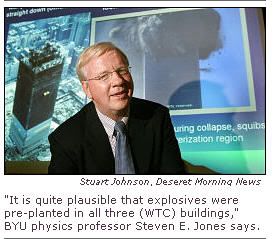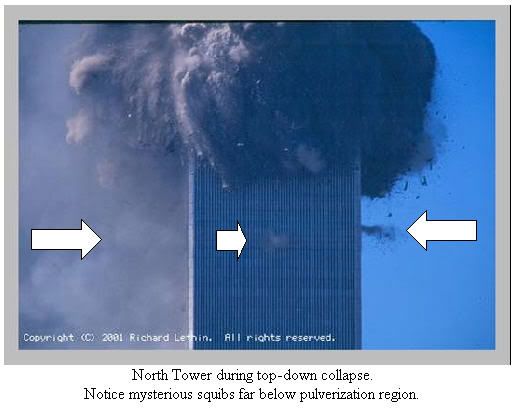
From the Article:
The physics of 9/11 — including how fast and symmetrically one of the World Trade Center buildings fell — prove that official explanations of the collapses are wrong, says a Brigham Young University physics professor.
In fact, it's likely that there were "pre-positioned explosives" in all three buildings at ground zero, says Steven E. Jones.
In a paper posted online Tuesday and accepted for peer-reviewed publication next year, Jones adds his voice to those of previous skeptics, including the authors of the Web site www.wtc7.net, whose research Jones quotes. Jones' article can be found at www.physics.byu.edu/research/energy/htm7.html.
Stuart Johnson, Deseret Morning News"It is quite plausible that explosives were pre-planted in all three (WTC) buildings," BYU physics professor Steven E. Jones says. Jones, who conducts research in fusion and solar energy at BYU, is calling for an independent, international scientific investigation "guided not by politicized notions and constraints but rather by observations and calculations.
"It is quite plausible that explosives were pre-planted in all three buildings and set off after the two plane crashes — which were actually a diversion tactic," he writes. "Muslims are (probably) not to blame for bringing down the WTC buildings after all," Jones writes.

Jones Offers the Following Evidence in His Report:
• The three buildings collapsed nearly symmetrically, falling down into their footprints, a phenomenon associated with "controlled demolition" — and even then it's very difficult, he says. "Why would terrorists undertake straight-down collapses of WTC-7 and the Towers when 'toppling over' falls would require much less work and would do much more damage in downtown Manhattan?" Jones asks. "And where would they obtain the necessary skills and access to the buildings for a symmetrical implosion anyway? The 'symmetry data' emphasized here, along with other data, provide strong evidence for an 'inside' job."
• No steel-frame building, before or after the WTC buildings, has ever collapsed due to fire. But explosives can effectively sever steel columns, he says.
• WTC 7, which was not hit by hijacked planes, collapsed in 6.6 seconds, just .6 of a second longer than it would take an object dropped from the roof to hit the ground. "Where is the delay that must be expected due to conservation of momentum, one of the foundational laws of physics?" he asks. "That is, as upper-falling floors strike lower floors — and intact steel support columns — the fall must be significantly impeded by the impacted mass. . . . How do the upper floors fall so quickly, then, and still conserve momentum in the collapsing buildings?" The paradox, he says, "is easily resolved by the explosive demolition hypothesis, whereby explosives quickly removed lower-floor material, including steel support columns, and allow near free-fall-speed collapses." These observations were not analyzed by FEMA, NIST nor the 9/11 Commission, he says.
• With non-explosive-caused collapse there would typically be a piling up of shattering concrete. But most of the material in the towers was converted to flour-like powder while the buildings were falling, he says. "How can we understand this strange behavior, without explosives? Remarkable, amazing — and demanding scrutiny since the U.S. government-funded reports failed to analyze this phenomenon."
• Horizontal puffs of smoke, known as squibs, were observed proceeding up the side the building, a phenomenon common when pre-positioned explosives are used to demolish buildings, he says.
• Steel supports were "partly evaporated," but it would require temperatures near 5,000 degrees Fahrenheit to evaporate steel — and neither office materials nor diesel fuel can generate temperatures that hot. Fires caused by jet fuel from the hijacked planes lasted at most a few minutes, and office material fires would burn out within about 20 minutes in any given location, he says.
• Molten metal found in the debris of the World Trade Center may have been the result of a high-temperature reaction of a commonly used explosive such as thermite, he says. Buildings not felled by explosives "have insufficient directed energy to result in melting of large quantities of metal," Jones says.
• Multiple loud explosions in rapid sequence were reported by numerous observers in and near the towers, and these explosions occurred far below the region where the planes struck, he says.
Professor Steven Jones joins other notable critics of the absurdity of the official 19-highjackers-operating-from-a-cave-in Afganistan fable including: Morgan Reynolds, Ed Asner, Paul Craig Roberts, Michael Ruppert, Ed Begley, Karl Schwartz, Michael Rivero, and Etienne De La Boetie to name but a few...

